Physical Address
304 North Cardinal St.
Dorchester Center, MA 02124
A wide variety of conditions affecting the skin and subcutaneous tissues present as papulonodular lesions, or ‘lumps and bumps.’ Benign and malignant neoplasms, hamartomas, and inflammatory and infectious disorders, as well as a number of infiltrative diseases, can be included in this category. Some of these conditions are discussed in detail in other chapters. This section deals with a group of nonmalignant disorders that present as discrete, circumscribed skin lesions or hamartomas in newborns and young infants.
The fibromatoses represent a diverse collection of mesenchymal tumors characterized by fibroblastic–myofibroblastic proliferation. They are locally invasive neoplasms that do not metastasize but which may recur following surgical excision. They vary in clinical behavior, from benign lesions that regress spontaneously to aggressive life-threatening tumors. They can be solitary or multifocal, and may exhibit skin, soft tissue, bone, or visceral involvement. Most of these tumors are sporadic, but some occur in a familial setting.
The fibromatoses are classified as juvenile or adult ( Box 26.1 ). The juvenile fibromatoses are a unique group of fibroblastic–myofibroblastic proliferations that present at birth or in the first years of life ( Table 26.1 ), accounting for approximately 12% of pediatric soft tissue tumors. Adult-type fibromatoses are occasionally observed in infancy and childhood. The fibromatoses have also been subdivided according to the site of fibrous tissue overgrowth into superficial or fascial, and deep or musculoaponeurotic (desmoid type).
| Location | Inheritance | Associated features | Course | Treatment | |
|---|---|---|---|---|---|
| Infantile myofibromatosis | Solitary, multicentric or generalized | Sporadic, autosomal dominant | Lytic bone lesions, visceral involvement | Spontaneous regression of bone and skin lesions; visceral lesions may be fatal | Await spontaneous regression, local excision if necessary; ‘?’ chemotherapy or radiation for visceral lesions |
| Infantile desmoid-type fibromatosis | Any site | Usually sporadic, autosomal dominant | Other congenital anomalies | Locally invasive; does not metastasize; recurs after excision | Local excision with wide margins; ‘?’ chemotherapy for non-resectable lesions |
| Fibromatosis colli | Neck | Rarely familial | None | Spontaneous regression | Physiotherapy |
| Infantile digital fibromatosis | Fingers and toes | Sporadic | None | Spontaneous regression reported; may recur | Await spontaneous regression; local excision if necessary |
| Fibrous hamartoma of infancy | Axillae, shoulders, chest wall | Sporadic | None | Does not regress | Local excision |
| Gingival fibromatosis | Gums | Autosomal dominant, recessive | Generalized hypertrichosis | May interfere with ability to eat, speak | Surgical debulking |
| Juvenile hyaline fibromatosis | Nodules on face and elsewhere | Autosomal recessive | Gingival hypertrophy, joint contractures | Chronic physical and cosmetic disability, overlaps with ISH | Supportive care, surgical excision of nodules if necessary |
| Infantile systemic hyalinosis (ISH) | Generalized thickening of skin | Autosomal recessive | Painful joint contractures, protein-losing enteropathy | Usually fatal within first few years of life | Supportive care |
The term infantile myofibromatosis was introduced by Chung and Enzinger in 1981 to designate a disorder previously described under numerous synonyms, including congenital multiple fibromatosis, diffuse congenital fibromatosis, multiple congenital mesenchymal tumors, and multiple vascular leiomyomas of the newborn. There are three clinical patterns of presentation: solitary infantile myofibroma; multicentric infantile myofibromatosis, with multiple lesions in the skin, soft tissues, and bone; and generalized infantile myofibromatosis, in which there is also visceral involvement.
Over 80% of myofibromas present in the first 2 years of life, and 60% are apparent at birth or shortly thereafter. Lesions may be superficial or deep, involving the skin, subcutaneous tissues, and muscle. They appear clinically as discrete, rubbery, firm to hard nodules measuring from 0.5 to 8 cm in diameter ( Fig. 26.1 ). Cutaneous myofibromas may be skin-colored or have a prominent vascular appearance, resembling hemangioma. Sites of predilection for solitary lesions are the head, neck, trunk, and upper extremities. In the multicentric and generalized forms there are multiple and widespread myofibromas, numbering from a few to over 100 ( Fig. 26.2 ). Skin and soft tissue lesions are asymptomatic and usually cause little morbidity. Rarely, a myofibroma presents with surface ulceration or an atrophic morphology ( Fig. 26.3 ). Joint contractures have been observed with extensive limb lesions.
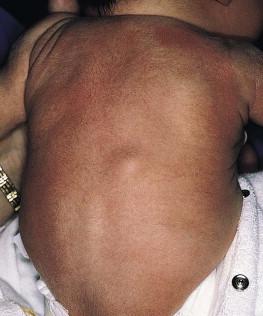
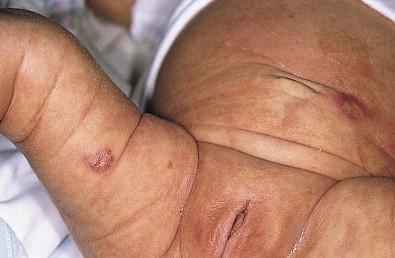

In the multicentric form of the disease, myofibromas in the skin and soft tissues are associated with multiple lytic bone lesions. These may be extensive and can involve any bone. Progression in size and number has been observed during infancy. The bone tumors eventually stabilize, and spontaneous healing occurs with complete regression during the first few years of life. The development of sclerotic borders around lytic areas may be an early sign of regression. In most cases, there are no clinical signs or symptoms of bone disease. Pathologic fractures may occur rarely and usually heal without residual deformity. Vertebral body collapse has been described, with residual loss of vertebral height in early childhood. There are reports of spinal cord compression resulting from solitary or multicentric lesions involving the spinal canal. Solitary infantile myofibroma may also occur in the orbit.
The much rarer generalized form of infantile myofibromatosis is characterized by involvement of visceral organs in addition to skin, soft tissue, and bone tumors. The gastrointestinal tract, heart, and lungs are most frequently affected. Involvement of the central nervous system is rare. Myofibromatosis in visceral organs is locally invasive and may severely compromise organ function. Cardiopulmonary, gastrointestinal, and hepatobiliary complications can be fatal, particularly in the newborn period or early infancy. There have been two reports of associated aneurismal dilatations of arteries as observed in fibromuscular dysplasia.
Multiple skin and soft tissue tumors may occasionally occur in the absence of bone or visceral involvement. Conversely, bone involvement has been observed in association with a single soft tissue lesion, or in the absence of skin lesions.
The pathogenesis is unknown. Most cases are sporadic. Familial occurrence is associated with autosomal dominant inheritance.
Myofibromatosis may be suspected by the presence of firm, cutaneous and subcutaneous nodules. A biopsy is required to confirm the diagnosis. All three forms of infantile myofibromatosis show interlacing fascicles of spindle-shaped fibroblasts. Central vascular areas resembling hemangiopericytoma are variably present. Focal necrosis, calcification, hyalinization, macrophages containing hemosiderin, and chronic inflammation may be seen. A giant cell variant containing multiple multinucleated giant cells has also been described. There is positive immunoreactivity for vimentin and actin, consistent with the presumed myofibroblastic derivation of the tumor; desmin staining is variable. Electron microscopy shows cells with features of both fibroblasts and smooth muscle cells.
Infants with cutaneous myofibromas should be evaluated for bone and visceral involvement, particularly when there are multiple lesions. Recommended initial investigations include a skeletal survey, chest X-ray, echocardiogram, and abdominal imaging studies.
Infantile myofibromatosis can be distinguished from other pediatric soft tissue tumors by histopathologic examination of biopsy material. These include other forms of fibromatosis, as well as congenital fibrosarcoma, leiomyoma and leiomyosarcoma, neurofibroma, metastatic neuroblastoma, hemangioma, hemangiopericytoma, chondromatosis, stiff skin syndrome, and nodular fasciitis.
The prognosis for infantile myofibromatosis is good in the absence of visceral involvement. Lesions in the skin and soft tissues show spontaneous involution during the first few years of life, sometimes leaving residual areas of skin atrophy or hyperpigmentation ( Fig. 26.4 ). Bone lesions also regress spontaneously, usually without significant disability or residual radiologic change. They do not interfere with enchondral bone growth. The prognosis is grave for newborns with visceral disease, in whom a mortality rate of 76% has been documented.
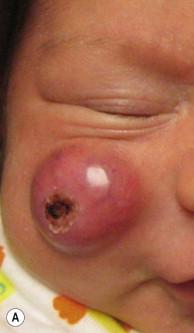
Surgical excision may be necessary to obtain tissue for diagnosis. Otherwise, excision should be limited to lesions that result in functional impairment or severe cosmetic disability. The role of chemotherapy or radiation for symptomatic, recurrent, or nonresectable disease is not established. Successful treatment of life-threatening generalized infantile myofibromatosis and multicentric disease using low-dose chemotherapy has been reported.
Although desmoid fibromatosis has traditionally been considered a deep fibromatosis of adulthood, with abdominal, intra-abdominal, and extra-abdominal variants, a specific juvenile subset is recognized. Description of this entity under a variety of synonyms, including among others aggressive fibromatosis of infancy, musculoaponeurotic fibromatosis, desmoma, and fibrosarcoma grade 1 desmoid type, has led to confusion in the literature. Up to 30% of juvenile desmoid tumors present in the first year of life, and congenital cases have been reported.
Infantile desmoid-like or aggressive fibromatosis involves deep tissues and is generally extra-abdominal. The usual clinical presentation is a slowly growing, nontender subcutaneous mass that has been present for weeks or months ( Fig. 26.5 ). Sites of predilection in children are the head and neck, extremities, shoulder girdle, trunk, and hip regions. The abdomen, retroperitoneum, spermatic cord, and breast may also be involved. Rarely, there are multiple lesions. The tumor tends to be very locally aggressive, with infiltration of adjacent skeletal muscles, tendons, or periosteum, and erosion of bone.
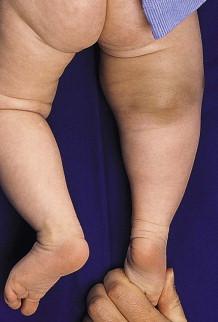
Approximately 12% of pediatric patients with desmoid fibromatosis have other congenital abnormalities. Adult-type intra-abdominal desmoid tumors are associated with familial adenomatous polyposis (FAP) and Gardner syndrome. Although most tumors in children are sporadic, there are reported cases of associated Gardner syndrome in childhood, one of which presented in infancy.
The finding of minor radiologic bone abnormalities in 80% of patients with desmoids and 48% of their relatives suggests an autosomal dominant mode of inheritance. Antecedent trauma, including surgery or irradiation, is reported in 12–63% of patients with all forms of desmoid tumor. It is postulated that desmoid tumors are associated with a familial defect in the regulation of connective tissue and may be precipitated by multiple factors. Desmoid fibromas in adults and children can be associated with mutations in the adenomatosis polyposis coli ( APC ) or β-catenin CTNNB1 genes.
The tumor is composed of bundles of slender, uniform spindle cells surrounded by variable amounts of collagen. Cleft or slit-like blood vessels are variable in number and more abundant at the periphery. The fibrous proliferation may be indistinguishable from scar tissue, except that it infiltrates skeletal muscle and tendons. Cellularity is variable. Some childhood lesions have an increased number of mitoses and greater cellularity. Immunohistochemical and ultrastructural studies show that the lesion is composed of fibroblasts and myofibroblasts. Immunohistochemistry and genotyping may help to distinguish sporadic from FAP cases.
Myofibromatosis and other juvenile fibromatoses should be considered in the differential diagnosis. Keloid scars are more superficial than desmoid tumors. Cellular variants must be distinguished histopathologically from fibrosarcoma.
Local excision with wide margins, if possible, is the mainstay of treatment. The recurrence rate varies from 30–80%. Higher recurrence rates are associated with a young age at diagnosis, large lesions, intralesional or marginal excision, and intra-abdominal location. Microscopic features of high vascularity, myxoid foci, and abundant immature myofibroblasts are associated with a higher recurrence rate. Treatment with combination chemotherapy and radiotherapy, or with tamoxifen and nonsteroidal anti-inflammatory agents, has been advocated for nonresectable, symptomatic or progressive disease. Mortality from locally aggressive desmoids is less than 10%.
Fibromatosis colli, also known as sternocleidomastoid pseudotumor of infancy or congenital muscular torticollis, is a congenital fibromatosis of the sternocleidomastoid muscle. It occurs in up to 0.4% of live newborns. Males are affected more than females. It does not involve the skin.
A hard, nontender, lobulated subcutaneous mass is palpable in the lower third of the sternocleidomastoid muscle. The trapezoid muscle is sometimes involved. Following an initial rapid period of growth, the tumor stabilizes in size. Torticollis and facial asymmetry are variable and may be transient. There is a right-sided predominance, and 2–3% of cases are bilateral.
The pathogenesis is unknown. Birth trauma has been implicated in 50% of cases, with a history of complicated delivery; whether this is a cause or an effect of the tumor is not clear. Familial cases are rare.
Histopathologically, bands of fibroblasts with abundant collagen are intermingled with residual angulated skeletal muscle fibers. The diagnosis may be established by fine-needle aspiration, which shows benign spindle cells and degenerating skeletal muscle fibers. Ultrasound or magnetic resonance imaging may also be useful.
A combination of the typical location of the lesion in the neck and the characteristic histopathology is diagnostic. The clinical differential diagnosis of a neck swelling includes lymphatic malformation, hemangioma, and malignant neoplasms. The histopathologic features may resemble those of a desmoid tumor.
The majority of lesions regress within the first year of life. Most resolve completely, but minor residual asymmetry or tightening of the sternocleidomastoid muscle is seen in 25% of cases. Only 9% have persistence of the tumor and torticollis. Physiotherapy is the treatment of choice. Surgery is rarely necessary unless the diagnosis is in doubt or the mass fails to resolve.
Infantile digital fibromatosis is a recurring myofibroblastic proliferation of the fingers and toes. Synonyms for this tumor include digital fibrous tumor of Reye, digital fibrous swelling, recurring digital fibrous tumor of childhood, and inclusion body fibromatosis.
Almost all lesions are diagnosed in infancy, and one-third are present at birth. Both sexes are affected equally. The typical lesion is an asymptomatic, firm, smooth, pink nodule located on the lateral or dorsal aspect of the digit, measuring <3 cm in diameter ( Fig. 26.6 ). Lesions are more common on the fingers than on the toes. The thumbs and great toes are spared. There is often deformity of the affected digit. There may be single or multiple nodules ( Fig. 26.7 ). Rarely, more than one digit is involved or extradigital lesions are seen.
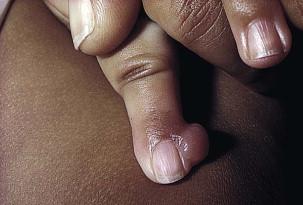
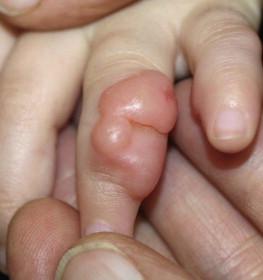
Periosteal attachment is not unusual, but underlying bone erosion is rare.
The pathogenesis is not known. Defective organization of actin filaments in myofibroblasts has been hypothesized.
Whorls and interdigitating sheets of uniform fibroblasts in a densely collagenous stroma are seen in the dermis or subcutis. A unique feature is the presence of distinctive, eosinophilic, perinuclear cytoplasmic inclusions surrounded by a clear halo that stain red with a trichrome stain. Electron microscopy shows abundant cytoplasmic filaments that form whorled bodies; these are the ultrastructural correlate of the cytoplasmic inclusions. Immunostaining is positive for desmin, actin, vimentin, and keratin.
The digital location and the characteristic histopathology distinguish this lesion from other fibromatoses and pediatric soft tissue tumors.
The local recurrence rate is 60–90% following surgical excision. Many tumors regress spontaneously within a few years. Conservative management without surgery is appropriate, unless there is functional impairment. Mohs micrographic surgery to debulk the tumor has been performed. Successful treatment with intralesional fluorouracil injections has been reported in a 7-year-old child.
Fibrous hamartoma of infancy is a benign fibrous tumor that develops during the first 2 years of life. Up to 20% are present at birth. Occasional cases have been described in children between 2 and 10 years. Males are affected more frequently than females.
Fibrous hamartoma presents as a subcutaneous lesion located around the axillae, shoulders, and upper chest wall. It may involve other sites, such as the inguinal region, extremities, and head and neck. It is usually a solitary nodule, measuring 2–5 cm in diameter, that feels lumpy to palpation. There may be overlying hypertrichosis. Occasionally, these lesions are multifocal. There are no symptoms.
There are no systemic associations.
Fibrous hamartoma of infancy is believed to represent a hamartomatous process rather than a true neoplasm. It is not familial.
The hamartoma is located in the subcutaneous and musculoaponeurotic tissues. Histopathologic examination reveals three characteristic elements: a fibrous component consisting of well-defined fascicles of fibroblasts or disorderly fibroblasts in a collagenous stroma; mature adipose tissue; and myxoid mesenchymal tissue in a basophilic matrix. Electron microscopy reveals the presence of both fibroblasts and myofibroblasts, primitive mesenchymal cells, small blood vessels, and mature adipocytes.
The clinical differential diagnosis of fibrous hamartoma of infancy includes a macrocystic lymphatic malformation, hemangioma, and other soft tissue tumors. Identification of the three histopathologic components of this lesion distinguishes it from other fibroblastic proliferations. A similar hamartoma with an admixture of fat and an absence of fibromyxoid tissue is described as lipofibromatosis.
There is no tendency to spontaneous regression. The treatment of choice is surgical excision. The recurrence rate is low, even with incomplete excision.
Lipofibromatosis is a rare, slowly growing tumor of fibroblasts and mature adipose tissue. It affects infants and young children and is congenital in up to 25% of cases. The tumor typically arises on the distal extremities and is less often encountered on the head and neck. Lesions range in size from 2–7 cm in diameter.
Histopathologically, there is abundant adipose tissue traversed by fascicles of fibroblasts with variable collagen and focal myxoid change. Spindle cells stain positive for smooth muscle actin.
The differential diagnosis of lipofibromatosis includes fibrolipoma, lipofibromatous hamartoma, fibrous hamartoma of infancy, lipoblastoma, and desmoid fibromatosis. Treatment is by surgical resection but the rate of recurrence or persistent growth is high.
This is a rare familial disorder that manifests at the time of eruption of the deciduous or permanent teeth.
There is slowly progressive gingival enlargement that may cover the crowns of the teeth and result in difficulty in eating or speaking. It is associated with generalized hypertrichosis.
Rarely there is associated mental retardation and epilepsy. The Zimmerman–Laband syndrome is characterized by gingival fibromatosis, hypertrichosis, intellectual disability, and absence and/or hypoplasia of the nails or terminal phalanges of the hands and feet as well as other anomalies.
Inheritance is most commonly autosomal dominant and the disorder has been mapped to loci on chromosomes 2 and 5. Autosomal recessive and sporadic cases are also reported.
Mucosal biopsy shows coarse, interlacing collagen bundles with sparse fibroblasts and myofibroblasts. There may be calcification, ossification, abundant amorphous extracellular material, and cellular fibroblastic proliferation.
The differential diagnosis includes phenytoin usage, chronic gingivitis, cherubism, juvenile hyaline fibromatosis, and other rare syndromes.
Treatment options include repeated surgical debulking of the gums or dental extraction.
The superficial fibromatoses of adulthood are the most common type of fibromatosis in the general population but are rare in infants and children. Fibromatosis may involve the palm (Dupuytren contracture), the plantar surface of the foot (Ledderhose disease), or the penis (Peyronie disease). Dupuytren-type fibromatosis of the palms and soles may be seen in childhood, and is occasionally congenital ( Fig. 26.8 ![]() ). Surgical excision is only necessary for diagnosis or for release of contractures. Knuckle pads are seen in older children and adolescents but not in infants.
). Surgical excision is only necessary for diagnosis or for release of contractures. Knuckle pads are seen in older children and adolescents but not in infants.
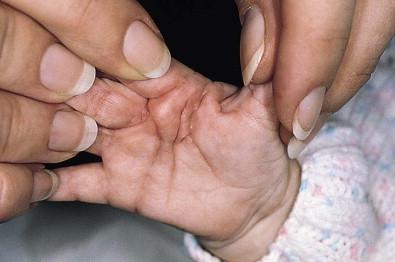
Leiomyoma is a benign tumor of smooth muscle. Cutaneous leiomyoma may arise from the arrector pili muscle in hair follicles, the dartos muscle of the scrotum and labia majora, the erectile muscle of the nipple, and the muscular wall of veins (angioleiomyoma). Leiomyomas are uncommon in children and are extremely rare in the newborn period.
Cutaneous leiomyomas appear as discrete papules or nodules with a pink or brown discoloration of the overlying skin. They are usually solitary but may be multiple. Rarely, a leiomyoma may present as a pedunculated mass at birth or as a papular plaque in early infancy. Leiomyomas are often painful, particularly on exposure to cold. Leiomyomas of the tongue are also reported.
Most cutaneous leiomyomas are not associated with visceral disease. The multiple leiomyomas of the esophagus and tracheobronchial tree in Alport syndrome may be associated with female genital leiomyomas in older children and adults. Leiomyomas that occur in immunocompromised children only rarely involve the skin or soft tissues.
Multiple cutaneous leiomyomas presenting in adolescence or adult life may be inherited as an autosomal dominant trait, but the etiology of other forms is unknown.
Become a Clinical Tree membership for Full access and enjoy Unlimited articles
If you are a member. Log in here